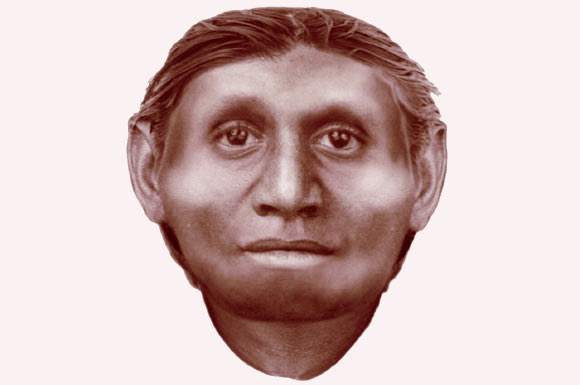A fresh study on Homo floresiensis, conducted by Prof Robert Eckhardt of Pennsylvania State University and his colleagues, suggests that LB1 – the primary specimen on which the mysterious human species was described – is, in fact, a Homo sapiens with Down syndrome.

Facial approximation of Homo floresiensis. Image credit: Susan Hayes / Australian Archaeological Association.
The name Homo floresiensis was invented for nine fragmentary skeletons of small-bodied hominins found in the Liang Bua Cave on the Indonesian island of Flores in 2003.
Among the specimens discovered were an 18,000-year-old almost complete skull, labeled LB1, and a partial skeleton.
According to initial studies, LB1 was an adult of about 30, probably female, and had unusual anatomical characteristics – a cranial volume reported as only 380 cubic centimeters (cc), suggesting a brain less than one third the size of an average modern human’s and short thigh bones, which were used to reconstruct a creature standing 1 m tall.
Although LB1 lived about 18,000 years ago, comparisons were made to earlier hominins, including Homo erectus and Australopithecus.
Other traits were characterized as unique and therefore indicative of a distinct species of Homo.
A thorough re-examination of the available evidence suggests a different explanation.
“In the first place, the original figures for cranial volume and stature are underestimates, markedly lower than any later attempts to confirm them,” Prof Eckhardt said.
He and his co-authors have consistently found a cranial volume of about 430 cc.
“The difference is significant, and the revised figure falls in the range predicted for a modern human with Down syndrome from the same geographic region,” Prof Eckhardt explained.
The original estimate of 1 m for the Homo floresiensis‘ height was based on extrapolation combining the short thigh bone with a formula derived from an African pygmy population.
“But humans with Down syndrome also have diagnostically short thigh bones,” Prof Eckhardt said.
“Though these and other features are unusual. Unusual does not equal unique. The originally reported traits are not so rare as to have required the invention of a new hominin species.”
Instead, the scientists build the case for an alternative diagnosis: that of Down syndrome, one of the most commonly occurring developmental disorders in modern humans.
Prof Eckhardt explained: “LB1’s short thigh bones not only match the height reduction seen in Down syndrome, but when corrected statistically for normal growth, they would yield a stature of about 1.26 m, a figure matched by some humans now living on Flores and in surrounding regions.”
The Down-like characteristics are present only in LB1, and not in the other Liang Bua skeletal remains, further evidence of LB1’s abnormality.
“This work is not presented in the form of a fanciful story, but to test a hypothesis: are the skeletons from Liang Bua cave sufficiently unusual to require invention of a new human species? Our reanalysis shows that they are not,” Prof Eckhardt concluded.
The findings appear in two papers in the Proceedings of the National Academy of Sciences.
_____







